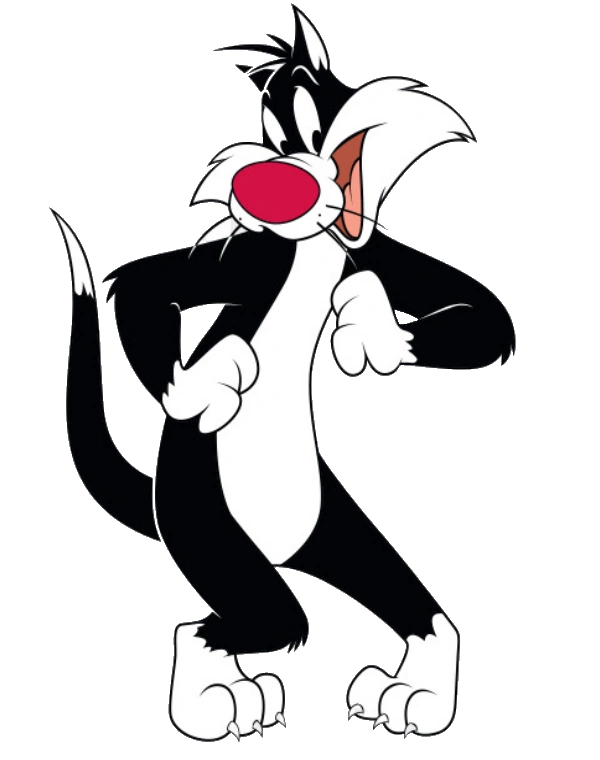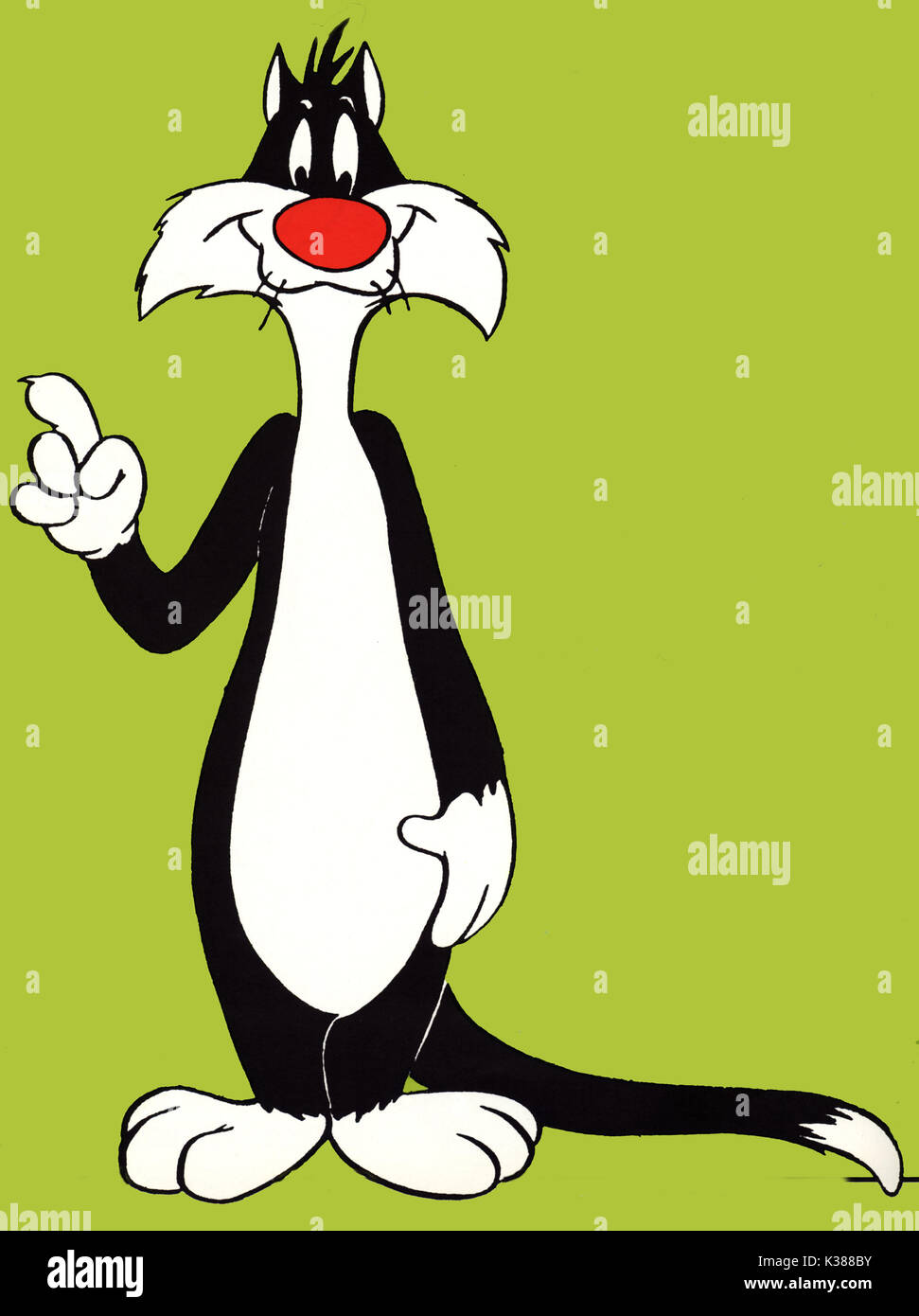Sylvester The Cat: Unmasking Looney Tunes' Iconic Tuxedo Terror
Sylvester the Cat is a fictional character, an anthropomorphic cat who has etched his paw prints deep into the annals of animation history. Known for his relentless, yet perpetually unsuccessful, pursuit of various adversaries, particularly Tweety Bird, Sylvester has become a beloved icon of the Looney Tunes and Merrie Melodies series of cartoons. His distinctive lisp, his catchphrase "Sufferin' Succotash!", and his classic tuxedo cat appearance have made him instantly recognizable to generations of fans worldwide.
From his debut in 1945, Sylvester quickly ascended to prominence, solidifying his place as one of Warner Bros.' most enduring characters. While his primary objective often revolved around a feathered meal, his comedic antics and the sheer determination in the face of constant failure have endeared him to audiences, proving that even a persistent loser can win hearts. This article delves into the fascinating world of Sylvester the Cat, exploring his origins, his memorable rivalries, his enduring legacy, and his significant impact on popular culture.
Table of Contents
- Sylvester the Cat: A Character Profile
- The Genesis of a Feline Legend: Sylvester's Origins
- The Golden Age Dominance: Sylvester's Prolific Appearances
- The Pursuit of Perfection: Sylvester's Iconic Rivalries
- The Voice and the Vocal Quirks: Sylvester's Auditory Identity
- Beyond the Chase: Sylvester's Relationships and Owners
- Sylvester in Modern Media: Cameos and Continuations
- Merchandise and Cultural Impact: The Legacy of Sylvester the Cat
Sylvester the Cat: A Character Profile
Before diving deeper into his animated escapades, let's establish some fundamental facts about Sylvester the Cat. This profile provides a snapshot of the character's key attributes and historical milestones.| Attribute | Detail |
|---|---|
| Full Name | Sylvester J. Pussycat, Sr. (commonly known as Sylvester the Cat) |
| Species | Anthropomorphic Tuxedo Cat |
| First Appearance | "Life with Feathers" (1945), directed by Friz Freleng. (Note: A silent cameo in "Jailbird and Jailbunny" during the song "Blow My Stack" is also noted, but "Life with Feathers" is generally cited as his official debut.) |
| Creator | Friz Freleng |
| Signature Physical Traits | Black and white fur (tuxedo pattern), big red nose, whiskers, large eyes, black and white tail. |
| Signature Vocal Traits | Lisp, catchphrase "Sufferin' Succotash!" |
| Primary Antagonists | Tweety Bird, Speedy Gonzales, Hippety Hopper |
| Notable Owners | Granny, Porky Pig (early appearances) |
| Original Voice Actor | Mel Blanc |
| Current Voice Actors | Jeff Bergman, Eric Bauza |
The Genesis of a Feline Legend: Sylvester's Origins
The creation of Sylvester the Cat is credited to the legendary animator Friz Freleng, a pivotal figure in the golden age of American animation. Sylvester first graced the screen in 1945, making his debut in the cartoon "Life with Feathers." While some sources note a silent cameo appearance in "Jailbird and Jailbunny" during a song sequence, "Life with Feathers" is widely recognized as his formal introduction to the world. From the outset, Sylvester's character was designed to be a persistent, albeit often clumsy, predator. His early development saw him quickly become a fan favorite, a testament to Freleng's genius in crafting relatable and hilariously flawed characters. The character's name itself is a clever pun on *silvestris*, the scientific name for the wild cat, which is the ancestor of domestic cats, adding a layer of subtle wit to his identity. This foundational period laid the groundwork for the enduring popularity of Sylvester the Cat, establishing his core personality traits that would define his future appearances.The Golden Age Dominance: Sylvester's Prolific Appearances
During the golden age of American animation, a period spanning roughly from the 1930s to the 1960s, Warner Bros. produced an astonishing volume of iconic cartoons. Within this prolific output, Sylvester the Cat emerged as one of the most frequently featured characters. He appeared in an impressive 103 cartoons during this era, a remarkable feat that solidified his status as a cornerstone of the Looney Tunes and Merrie Melodies franchises. This puts him in an elite group, lagging only behind superstars like Bugs Bunny, Porky Pig, and Daffy Duck in terms of sheer number of appearances. His consistent presence in so many shorts speaks volumes about his appeal and versatility as a character. Whether he was chasing a bird, a mouse, or a kangaroo, Sylvester's comedic struggles resonated with audiences, making him a reliable source of laughter and a central figure in Warner Bros.' animated universe. His high frequency of appearances allowed for the continuous development of his character, refining his gags and solidifying his place in the pantheon of animated greats.The Pursuit of Perfection: Sylvester's Iconic Rivalries
A significant portion of Sylvester the Cat's comedic identity is defined by his relentless, often futile, pursuits of various small creatures he deems as potential meals. These rivalries form the backbone of many of his most memorable cartoons, showcasing his determination, his cunning (or lack thereof), and his remarkable ability to endure endless slapstick punishment. Most of his appearances have him often chasing Tweety Bird, Speedy Gonzales, or Hippety Hopper, each dynamic offering a unique brand of humor.Sylvester and Tweety Bird: The Classic Cat and Canary Chase
The rivalry between Sylvester the Cat and Tweety Bird is arguably the most famous and enduring of all his animated conflicts. This classic cat-and-canary chase is the quintessential representation of Sylvester's character: a perpetually hungry cat foiled by a seemingly innocent, yet surprisingly cunning, little bird. The dynamic is simple yet endlessly entertaining: Sylvester devises elaborate schemes to catch Tweety, only for them to backfire spectacularly, often resulting in injury or humiliation for the feline. Tweety's iconic catchphrase, "I did taw a puddy tat!", often precedes Sylvester's latest failed attempt. When depicted with an owner, Sylvester is mainly with Granny, who serves as the protector of Tweety, adding another layer of comedic obstacle for Sylvester. Their interactions are a masterclass in comedic timing and visual gags, cementing their status as one of animation's most iconic duos. The sheer persistence of Sylvester, despite never truly succeeding, is what makes this rivalry so compelling and endlessly rewatchable.Sylvester and Speedy Gonzales: The Fastest Mouse in Mexico
While not as frequently featured as his battles with Tweety, Sylvester's attempts to catch Speedy Gonzales offer a different kind of comedic challenge. Speedy, known as "the fastest mouse in all Mexico," is a whirlwind of energy and speed, making him an incredibly elusive target for the slower, more methodical Sylvester. These cartoons often see Sylvester employing traps and strategies that are easily outmaneuvered by Speedy's lightning-fast reflexes and cunning. The humor in these shorts often stems from the stark contrast between Sylvester's frustrated attempts and Speedy's effortless evasion, frequently accompanied by Speedy's triumphant "Andale! Arriba!" This rivalry highlights Sylvester's adaptability, as he tries different tactics against a different type of prey, only to be met with the same comedic failure.Sylvester and Hippety Hopper: The Kangaroo Dilemma
Perhaps the most unusual of Sylvester's major rivalries is his ongoing struggle with Hippety Hopper, a baby kangaroo. In these shorts, Sylvester often mistakes Hippety for a giant mouse, leading to hilarious misunderstandings. Despite his size, Hippety Hopper is an innocent and playful character who unintentionally thwarts Sylvester's plans, often by simply bouncing around or using his powerful legs in self-defense. The comedic irony here is that Sylvester is usually terrified of Hippety, believing him to be a monstrous rodent, while the audience knows he's just a harmless joey. This dynamic adds a layer of absurdity to Sylvester's character, showcasing his capacity for misjudgment and fear, which further endears him to the audience. These less frequent but equally memorable appearances demonstrate the range of comedic situations Sylvester the Cat could be placed in.The Voice and the Vocal Quirks: Sylvester's Auditory Identity
A significant part of Sylvester the Cat's enduring appeal lies in his distinctive voice, originally brought to life by the legendary voice actor Mel Blanc. Blanc, known as "The Man of a Thousand Voices," imbued Sylvester with his trademark lisp and the iconic catchphrase, "Sufferin' Succotash!" This speech impediment became synonymous with the character, adding a unique comedic flair to his frustrated outbursts and monologues. The lisp wasn't just a gimmick; it enhanced Sylvester's persona, making him sound both endearing and slightly pathetic in his failures. After Mel Blanc's passing, the mantle of voicing Sylvester has been taken up by talented voice actors who have diligently maintained his signature vocal qualities. Jeff Bergman has notably reprised the role in various modern productions, including "Space Jam: A New Legacy," "Bugs Bunny Builders," and "Tiny Toons Looniversity." Eric Bauza also lent his voice to the character in "King Tweety." The consistency in preserving Sylvester's unique vocal identity across different eras and productions is crucial to his continued recognition and popularity, ensuring that new generations can experience the classic charm of Sylvester the Cat.Beyond the Chase: Sylvester's Relationships and Owners
While Sylvester the Cat is primarily known for his relentless pursuit of smaller creatures, his character is also shaped by his relationships with other Looney Tunes characters, particularly his owners. These dynamics often provide context for his actions and add layers to his personality beyond just being a hungry feline. Most famously, Sylvester is Granny's pet cat. In this role, he spends the majority of his time attempting to catch and eat Granny's other pet, Tweety. Granny, a sweet but stern elderly woman, is often oblivious to Sylvester's true intentions or quickly intervenes to protect Tweety, leading to further comedic frustration for Sylvester. This owner-pet dynamic adds a moral dimension to the chase, as Sylvester is not just a predator but also a mischievous pet trying to outwit his owner. Interestingly, very early in his career, Sylvester was also depicted with Porky Pig as his owner. These cartoons explored different scenarios, showcasing Sylvester in various comedic predicaments alongside Porky. While the Granny-Tweety-Sylvester trio became the most iconic, these earlier appearances with Porky Pig highlight the character's versatility and how his persona could adapt to different narrative frameworks. These relationships are integral to understanding the full scope of Sylvester the Cat's character development throughout the years.Sylvester in Modern Media: Cameos and Continuations
The enduring popularity of Sylvester the Cat extends far beyond the golden age of animation. He has remained a relevant and beloved character, making numerous appearances in modern media, showcasing his timeless appeal to new generations. His presence in contemporary productions demonstrates the lasting impact of his original cartoons and the continued demand for classic Looney Tunes characters. Sylvester has made notable appearances in feature films, most prominently in "Space Jam" (1996) and its sequel, "Space Jam: A New Legacy" (2021), where he was voiced by Jeff Bergman. These films brought him to a wider, global audience, integrating his classic antics into a modern narrative. Beyond the big screen, Sylvester has also popped up in various television series and specials. He made a cameo appearance in the "Tom and Jerry Tales" episode "Kitty Cat Blues," appearing on a poster, a nod to his fellow animated felines. He also had a vocal cameo in the 2020 "Animaniacs" revival segment "Suffragette City," with Jeff Bergman once again reprising his role, much to the delight of long-time fans. Furthermore, Sylvester the Cat has been featured in newer animated series like "Bugs Bunny Builders" and "Tiny Toons Looniversity," continuing his comedic legacy for younger viewers. These continuous appearances in diverse media formats underscore the character's adaptability and his firm place in popular culture, proving that Sylvester the Cat is far from retired.Merchandise and Cultural Impact: The Legacy of Sylvester the Cat
The influence of Sylvester the Cat stretches far beyond the animated screen, permeating various aspects of popular culture and leaving an indelible mark on merchandise. His iconic design and recognizable personality have made him a natural fit for a wide range of products, solidifying his status as a cultural icon. One of the most notable instances of Sylvester's commercial appeal was his role as the spokescat for 9 Lives' line of dry cat food. From 1979 to 1983, his distinctive face appeared prominently on the product's boxes, and he was featured in a series of television commercials. This partnership leveraged his feline identity and widespread recognition, turning him into a trusted figure for pet owners. This commercial endorsement is a testament to how deeply ingrained Sylvester the Cat had become in the public consciousness. Beyond commercial endorsements, Sylvester's image has adorned countless items, including toys, apparel, comic books, video games, and collectibles. His rivalry with Tweety Bird, in particular, has been a goldmine for merchandise, with products often featuring both characters in their classic chase dynamic. The catchphrase "Sufferin' Succotash!" and Tweety's "I did taw a puddy tat!" are instantly recognizable and frequently used in pop culture references, further cementing their legacy. The character's name itself, a pun on *silvestris* (the scientific name for the wild cat), reflects a cleverness that resonates with audiences. Sylvester the Cat represents the universal struggle of ambition versus reality, the comedic beauty of persistent failure, and the enduring charm of a character who simply refuses to give up. His presence in cartoons, films, and merchandise for over seven decades is a clear indicator of his profound and lasting cultural impact, ensuring that this tuxedo terror will continue to entertain and inspire laughter for generations to come.Conclusion
From his humble beginnings in 1945 as the creation of Friz Freleng, Sylvester the Cat has clawed his way into the hearts of millions, becoming one of the most enduring and beloved characters in the Looney Tunes universe. His distinctive tuxedo appearance, his trademark lisp, and his unforgettable catchphrase "Sufferin' Succotash!" have made him instantly recognizable across the globe. Whether he's tirelessly chasing Tweety Bird, attempting to outsmart Speedy Gonzales, or comically misunderstanding Hippety Hopper, Sylvester's unwavering determination in the face of perpetual failure is what truly defines his charm. Having appeared in over 100 Golden Age cartoons, lagging only behind the absolute superstars, Sylvester's legacy is undeniable. He represents the comedic everyman, the one who tries his hardest but just can't catch a break, a relatable struggle wrapped in hilarious animated antics. His continued presence in modern media, from "Space Jam" to "Tiny Toons Looniversity," and his past as a spokescat for 9 Lives, underscore his timeless appeal and significant cultural impact. Sylvester the Cat is more than just a cartoon character; he is a testament to the power of perseverance, even when success remains just out of reach. What are your favorite Sylvester the Cat moments? Do you root for him or for Tweety? Share your thoughts in the comments below, and don't forget to explore other articles on our site about your favorite Looney Tunes characters!
Sylvester the Cat - Wikipedia

Sylvester the Cat | Character-community Wiki | Fandom

Sylvester The Cat High Resolution Stock Photography and Images - Alamy